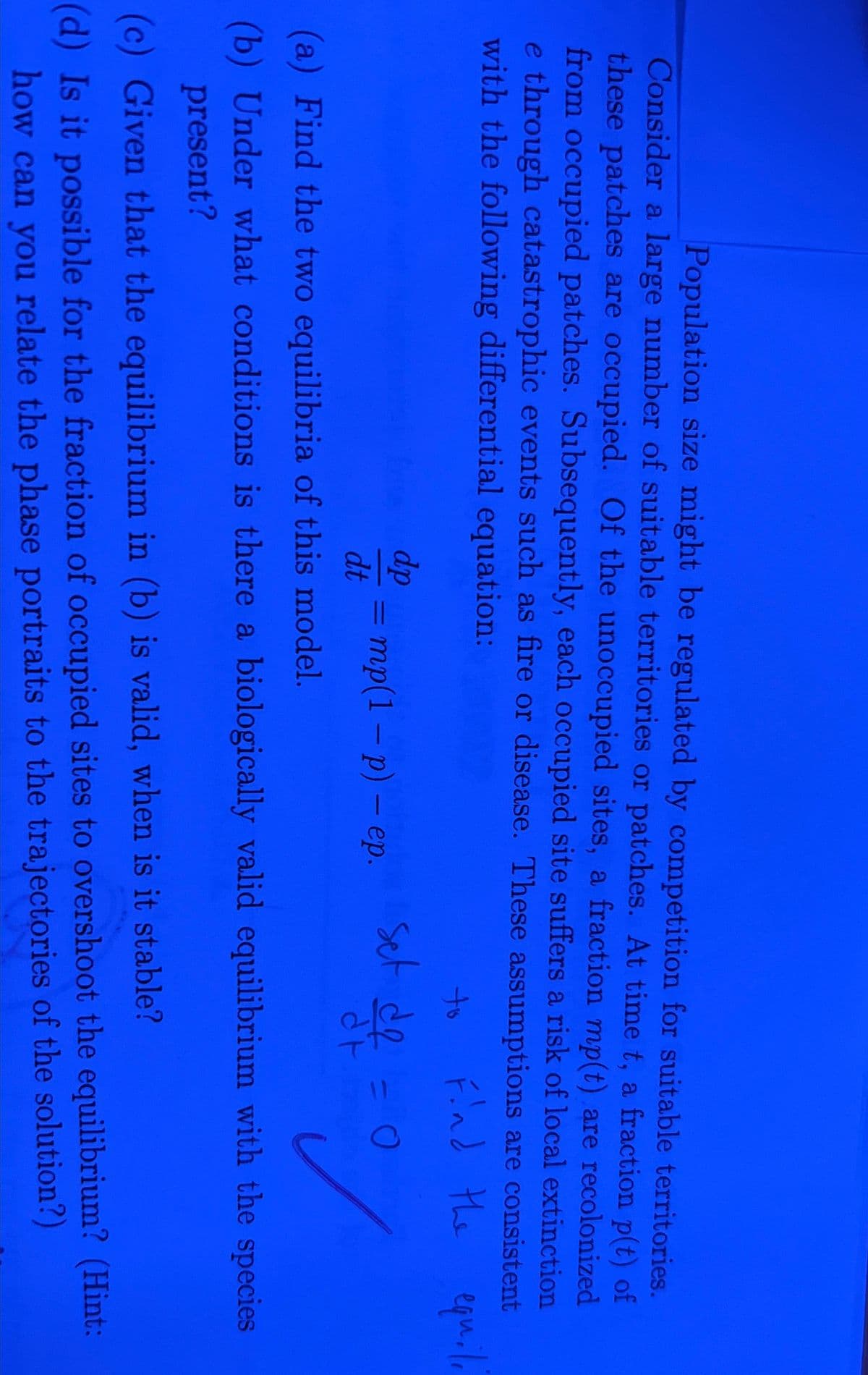Population size might be regulated by competition for suitable territories. Consider a large number of suitable territories or patches. At time t, a fraction p(t) of these patches are occupied. Of the unoccupied sites, a fraction mp(t) are recolonized from occupied patches. Subsequently, each occupied site suffers a risk of local extinction e through catastrophic events such as fire or disease. These assumptions are consistent with the following differential equation:
Population size might be regulated by competition for suitable territories. Consider a large number of suitable territories or patches. At time t, a fraction p(t) of these patches are occupied. Of the unoccupied sites, a fraction mp(t) are recolonized from occupied patches. Subsequently, each occupied site suffers a risk of local extinction e through catastrophic events such as fire or disease. These assumptions are consistent with the following differential equation:
Applications and Investigations in Earth Science (9th Edition)
9th Edition
ISBN:9780134746241
Author:Edward J. Tarbuck, Frederick K. Lutgens, Dennis G. Tasa
Publisher:Edward J. Tarbuck, Frederick K. Lutgens, Dennis G. Tasa
Chapter1: The Study Of Minerals
Section: Chapter Questions
Problem 1LR
Related questions
Question
Draw phase diagrams

Transcribed Image Text:Population size might be regulated by competition for suitable territories.
Consider a large number of suitable territories or patches. At time t, a fraction p(t) of
these patches are occupied. Of the unoccupied sites, a fraction mp(t) are recolonized
from occupied patches. Subsequently, each occupied site suffers a risk of local extinction
e through catastrophic events such as fire or disease. These assumptions are consistent
with the following differential equation:
to
Find the equili
dp
dt
(a) Find the two equilibria of this model.
(b) Under what conditions is there a biologically valid equilibrium with the species
present?
set &f=0 /
de
= mp(1-p) - ep.
(c) Given that the equilibrium in (b) is valid, when is it stable?
(d) Is it possible for the fraction of occupied sites to overshoot the equilibrium? (Hint:
how can you relate the phase portraits to the trajectories of the solution?)
Expert Solution
This question has been solved!
Explore an expertly crafted, step-by-step solution for a thorough understanding of key concepts.
This is a popular solution!
Trending now
This is a popular solution!
Step by step
Solved in 2 steps with 2 images

Recommended textbooks for you

Applications and Investigations in Earth Science …
Earth Science
ISBN:
9780134746241
Author:
Edward J. Tarbuck, Frederick K. Lutgens, Dennis G. Tasa
Publisher:
PEARSON

Exercises for Weather & Climate (9th Edition)
Earth Science
ISBN:
9780134041360
Author:
Greg Carbone
Publisher:
PEARSON

Environmental Science
Earth Science
ISBN:
9781260153125
Author:
William P Cunningham Prof., Mary Ann Cunningham Professor
Publisher:
McGraw-Hill Education

Applications and Investigations in Earth Science …
Earth Science
ISBN:
9780134746241
Author:
Edward J. Tarbuck, Frederick K. Lutgens, Dennis G. Tasa
Publisher:
PEARSON

Exercises for Weather & Climate (9th Edition)
Earth Science
ISBN:
9780134041360
Author:
Greg Carbone
Publisher:
PEARSON

Environmental Science
Earth Science
ISBN:
9781260153125
Author:
William P Cunningham Prof., Mary Ann Cunningham Professor
Publisher:
McGraw-Hill Education

Earth Science (15th Edition)
Earth Science
ISBN:
9780134543536
Author:
Edward J. Tarbuck, Frederick K. Lutgens, Dennis G. Tasa
Publisher:
PEARSON

Environmental Science (MindTap Course List)
Earth Science
ISBN:
9781337569613
Author:
G. Tyler Miller, Scott Spoolman
Publisher:
Cengage Learning

Physical Geology
Earth Science
ISBN:
9781259916823
Author:
Plummer, Charles C., CARLSON, Diane H., Hammersley, Lisa
Publisher:
Mcgraw-hill Education,